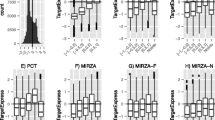Abstract
microRNAs are short RNAs that reduce gene expression by binding to their targets. Computational predictions indicate that all human genes may be regulated by microRNAs, with each microRNA possibly targeting thousands of genes. Commonly used software will produce a prohibitive number of predicted targets for each microRNA. Here I describe procedures that refine these predictions by integrating available software and expression data from experiments available online. These procedures are tailored to experiments where predicting true targets is more important than detecting all putative targets.
Access this chapter
Tax calculation will be finalised at checkout
Purchases are for personal use only
Similar content being viewed by others
References
Lee RC, Feinbaum RL, Ambros V (1993) The C. elegans heterochronic gene lin-4 encodes small RNAs with antisense complementarity to lin-14. Cell 75:843–854
Lai EC (2002) Micro RNAs are complementary to 3′ UTR sequence motifs that mediate negative post-transcriptional regulation. Nat Genet 30:363–364. doi:10.1038/ng865
Ritchie W, Flamant S, Rasko JE (2009) Predicting microRNA targets and functions: traps for the unwary. Nat Methods 6:397–398. doi:10.1038/nmeth0609-397, nmeth0609-397 [pii]
Friedman RC, Farh KK, Burge CB, Bartel DP (2009) Most mammalian mRNAs are conserved targets of microRNAs. Genome Res 19:92–105. doi:10.1101/gr.082701.108, gr.082701.108 [pii]
John B, Enright AJ, Aravin A et al (2004) Human MicroRNA targets. PLoS Biol 2:e363
Fan X, Kurgan L (2014) Comprehensive overview and assessment of computational prediction of microRNA targets in animals. Brief Bioinform 16:780–794. doi:10.1093/bib/bbu044
Ritchie W, Flamant S, Rasko JE (2010) mimiRNA: a microRNA expression profiler and classification resource designed to identify functional correlations between microRNAs and their targets. Bioinformatics 26:223–227. doi:10.1093/bioinformatics/btp649, btp649 [pii]
Krek A, Grün D, Poy MN et al (2005) Combinatorial microRNA target predictions. Nat Genet 37:495–500
Lim LP, Lau NC, Garrett-Engele P et al (2005) Microarray analysis shows that some microRNAs downregulate large numbers of target mRNAs. Nature 433:769–773
Ritchie W, Rajasekhar M, Flamant S, Rasko JE (2009) Conserved expression patterns predict microRNA targets. PLoS Comput Biol 5:e1000513. doi:10.1371/journal.pcbi.1000513
Alexiou P, Maragkakis M, Papadopoulos GL et al (2009) Lost in translation: an assessment and perspective for computational microRNA target identification. Bioinformatics 25:3049–3055. doi:10.1093/bioinformatics/btp565
Xiao F, Zuo Z, Cai G et al (2009) miRecords: an integrated resource for microRNA-target interactions. Nucleic Acids Res 37:D105–D110. doi:10.1093/nar/gkn851
Yang JH, Li JH, Shao P et al (2011) starBase: a database for exploring microRNA-mRNA interaction maps from Argonaute CLIP-Seq and Degradome-Seq data. Nucleic Acids Res 39:D202–D209. doi:10.1093/nar/gkq1056
Vergoulis T, Vlachos IS, Alexiou P et al (2012) TarBase 6.0: capturing the exponential growth of miRNA targets with experimental support. Nucleic Acids Res 40:D222–D229. doi:10.1093/nar/gkr1161
Lewis BP, Shih IH, Jones-Rhoades MW et al (2003) Prediction of mammalian microRNA targets. Cell 115:787–798, doi:S0092867403010183 [pii]
Author information
Authors and Affiliations
Corresponding author
Editor information
Editors and Affiliations
Rights and permissions
Copyright information
© 2017 Springer Science+Business Media New York
About this protocol
Cite this protocol
Ritchie, W. (2017). microRNA Target Prediction. In: Kasid, U., Clarke, R. (eds) Cancer Gene Networks. Methods in Molecular Biology, vol 1513. Humana Press, New York, NY. https://doi.org/10.1007/978-1-4939-6539-7_13
Download citation
DOI: https://doi.org/10.1007/978-1-4939-6539-7_13
Published:
Publisher Name: Humana Press, New York, NY
Print ISBN: 978-1-4939-6537-3
Online ISBN: 978-1-4939-6539-7
eBook Packages: Springer Protocols




